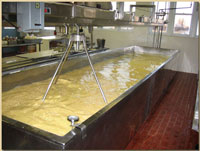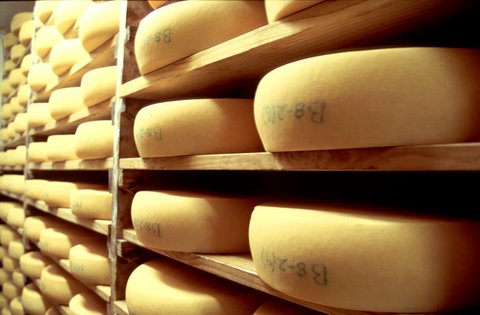
Cheese
Very few things are sacrosanct in this day, and cheese must now be classed among those things that have lost their halo. Cheese has been used for at least 4,000 years, and has been widely acclaimed as a healthful food. Some have claimed unusual hardiness and advanced old age for cheese users. Only recently has it been learned that cheese is not the wonder food that many had thought. There may be real dangers in its use.
All dairy products have become more suspect recently, from the association of the saturated fat of milk with the elevation of the blood cholesterol, to the transmission of many animal diseases to man through dairy products. Most of the diseases transmitted from animals are of a minor nature, resembling colds, flu, streptococcal sore throat, and other infections, but some diseases are life-threatening.
A battle is still going on with brucellosis, a disease contracted from milk, which threatens the quality of life for many years, giving a chronic low grade fever and below par performance to the afflicted person. Between 1883 and 1947, there were 59 epidemics caused by cheese, with 117 deaths in the United States alone.
Now, cheese is under special attack, not because of infectious diseases which it shares with all dairy products, but because of its basic chemistry. Cheese is made by the action of waste products from molds and bacteria on milk. Most foods contaminated with molds and bacteria produce such an unpleasant flavor that few people care to eat them. Generally, an unpleasant flavor in food heralds danger, and apparently this principle holds true for cheese, since most children naturally reject their first taste of cheese and must be taught to accept it.
Changes which occur in cheese during the fermenting and “ripening” process include the production of a toxic alkaloid called roquefortine (as in Roquefort dressing), a neurotoxin which can cause mice to have convulsive seizures. All blue cheeses probably contain roquefortine. The alkaloid is produced by the mold Penicillium roqueforti. The alkaloids are all toxic and include such widely differing poisons as coniine, one of the major volatile alkaloids found in the poison hemlock plant from which Socrates met his Waterloo; to caffeine, the major alkaloid in coffee, tea, colas, and chocolate.
Another class of toxic substances includes the toxic amines. Any fermented food or beverage may contain toxic amines. They can produce changes in the nervous system which bring on headaches, palpitations, high blood pressure, migraines, and other known disorders which occur at a cellular level.
Several toxic and nontoxic amines are produced during the fermentation of milk, tyramine being among them, the amine causing migraine headaches. The only cheeses containing tyramine in insignificant amounts are creamed cheese, ricotta cheese, and cottage cheese. Some other foods containing tyramine are chocolate, herring, yeast, broad beans, chicken livers, ripened sausages (bologna, summer sausages, salami, pepperoni, etc.), meat extracts, and alcoholic beverages. If a human follows his natural taste he will avoid anything that has the faintest taint of spoilage about it.
Milk, produced by glands that are actually modified sweat glands, is naturally high in salt. Cheese shares in this high salt content. A high salt intake increases one’s likelihood of having high blood pressure.
The rennet for the curdling process in cheese making is commonly obtained from the stomachs of calves. A combination of rennin and pepsin is sometimes used, or plant enzymes derived from fungus. Pepsin is obtained principally from fresh hog stomachs. Many processed cheeses have preservatives, emulsifying agents, and other chemicals added to them, that can have a harmful effect on the body. The putrefactive process through which milk goes to produce cheese reduces the vitamin content. Cheese is almost completely devoid of water soluble vitamins. Losses of both vitamins and minerals occur with the loss of whey.
Undesirable chemicals are produced by cheese-making that involve all three major constituents of cheese: fats, carbohydrates, and proteins. The fat in cheese is hydrolyzed to irritating fatty acids, butyric, caproic, caprylic and longer carbon-chain fatty acids. The carbohydrate of milk, mainly lactose is converted to lactic acid by putrefaction. The protein is fermented to peptides, amines, indoles, skatole, and ammonia, several of these being implicated in the production of cancer. The possibility of production of nitrosamine, one of the most powerful cancer producing agents known, is particularly disturbing. Both the nervous system and the gastrointestinal tract are irritated by certain of these substances, causing the individual to be irritable and cranky.
Of course, cheese also presents the usual drawbacks of milk such as allergies, lactose intolerance, food sensitivities, and high calorie content. Cheese contains a goodly quantity of the amino acid tryptophane, which causes after-meal drowsiness and inability to concentrate.
Certain imported cheeses have been discovered as culprits in outbreaks of food-borne gastroenteritis in the United States. As many as 120 disease-producing germs have been isolated per gram of cheese; that would be 600 germs in a teaspoon of cheese! We can say from the foregoing, that some foods generally thought to be wholesome are actually injurious to the health.
Other foods that develop a specific flavor through the activity of bacteria include sauerkraut, vinegar, pickles, butter, buttermilk, and cultured milk. The holes in Swiss cheese come from the action of gas forming bacilli, similar to those which form gas in the bowel.
Dr. Agatha Thrash
